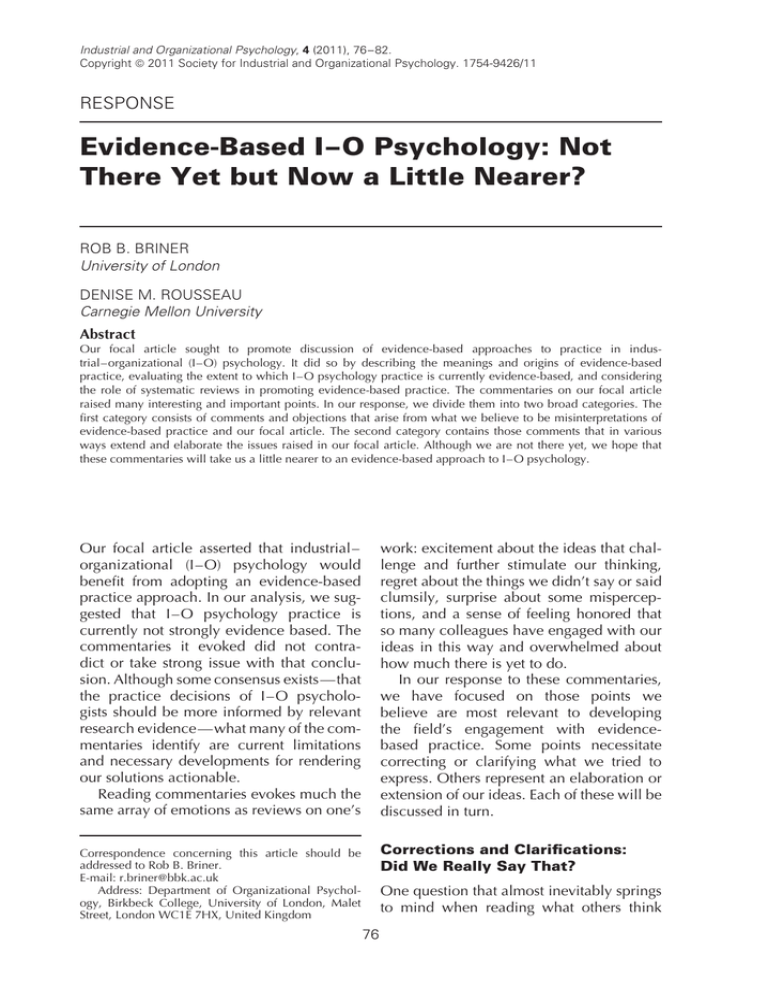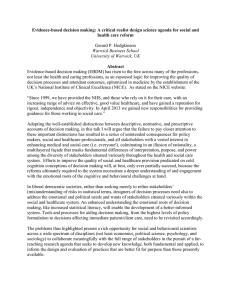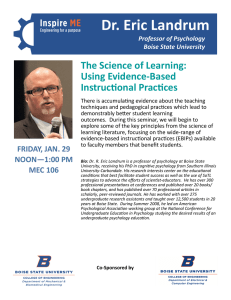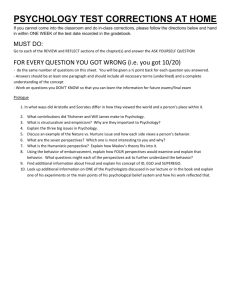Evidence-Based I –O Psychology: Not RESPONSE University of London
advertisement

Industrial and Organizational Psychology, 4 (2011), 76–82. Copyright © 2011 Society for Industrial and Organizational Psychology. 1754-9426/11 RESPONSE Evidence-Based I–O Psychology: Not There Yet but Now a Little Nearer? ROB B. BRINER University of London DENISE M. ROUSSEAU Carnegie Mellon University Abstract Our focal article sought to promote discussion of evidence-based approaches to practice in industrial–organizational (I–O) psychology. It did so by describing the meanings and origins of evidence-based practice, evaluating the extent to which I–O psychology practice is currently evidence-based, and considering the role of systematic reviews in promoting evidence-based practice. The commentaries on our focal article raised many interesting and important points. In our response, we divide them into two broad categories. The first category consists of comments and objections that arise from what we believe to be misinterpretations of evidence-based practice and our focal article. The second category contains those comments that in various ways extend and elaborate the issues raised in our focal article. Although we are not there yet, we hope that these commentaries will take us a little nearer to an evidence-based approach to I–O psychology. Our focal article asserted that industrial– organizational (I–O) psychology would benefit from adopting an evidence-based practice approach. In our analysis, we suggested that I–O psychology practice is currently not strongly evidence based. The commentaries it evoked did not contradict or take strong issue with that conclusion. Although some consensus exists—that the practice decisions of I–O psychologists should be more informed by relevant research evidence—what many of the commentaries identify are current limitations and necessary developments for rendering our solutions actionable. Reading commentaries evokes much the same array of emotions as reviews on one’s work: excitement about the ideas that challenge and further stimulate our thinking, regret about the things we didn’t say or said clumsily, surprise about some misperceptions, and a sense of feeling honored that so many colleagues have engaged with our ideas in this way and overwhelmed about how much there is yet to do. In our response to these commentaries, we have focused on those points we believe are most relevant to developing the field’s engagement with evidencebased practice. Some points necessitate correcting or clarifying what we tried to express. Others represent an elaboration or extension of our ideas. Each of these will be discussed in turn. Correspondence concerning this article should be addressed to Rob B. Briner. E-mail: r.briner@bbk.ac.uk Address: Department of Organizational Psychology, Birkbeck College, University of London, Malet Street, London WC1E 7HX, United Kingdom Corrections and Clarifications: Did We Really Say That? One question that almost inevitably springs to mind when reading what others think 76 Evidence-based I–O psychology: A Little nearer? about what we’ve written, particularly if it seems like a point of disagreement, is ‘‘Did we really say that?’’ Sometimes, we really did say that. If it was what we actually meant to say, then a substantive response is required. If, on the other hand, it was just a mistake, all that’s needed is an apology and correction. On other occasions, the answer seems to be ‘‘No, we didn’t say that.’’ What others seem to think we’ve said doesn’t relate to the words we put on the page. Dealing with this can be tricky. We don’t control how what we write is interpreted and implied meanings that seem obvious to some remain hidden to others. Dealing with this when the topic is evidence-based practice is even trickier. We have found that when writing about or discussing the topic (e.g., Briner, Denyer, & Rousseau, 2009), it is necessary first to spend some time stating what evidencebased practice is not. Even when concept familiarity is low, people come to the discussion armed with a set of firm beliefs that, if not surfaced, inhibit discussion. Although some of these corrections and clarifications are necessary because we poorly or only partially expressed our ideas, others seem to come with the evidencebased practice territory. Evidence from systematic reviews helps us to make decisions—it does not provide ‘‘The Answer.’’ Several commentaries (e.g., Baughman, Dorsey, & Zarefsky, 2011; Cassell, 2011) suggest that the focal article implied that by reviewing research evidence the answer to the problem would perhaps almost magically become obvious or indeed that the research evidence would somehow dictate the solution. This is not our view—not least as many other sources of information will come into play (see subsequent paragraphs). Bodies of research evidence can be complex, highly context dependent, and inconclusive. Rather than providing a single simple answer, evidence instead can inform and elaborate how a problem is understood. With more insight into a problem often comes new questions and possible solutions. In this sense, evidence-based practice approaches are 77 about learning as well as directly informing practice decisions. Importantly, solutions based on evidence also need to be informed by practice concerns, including goals and context (the kind of work, people, and settings, etc.). Taking a cue from how evidence-based practice has advanced in other fields, we anticipate seeing more collaborations between scholars and practitioners to develop tools, checklists, procedures, and their supports to translate evidence into appropriate actions. Research evidence is one, but only one, form of evidence used in evidence-based practice. In the focal article, we did pay particular attention to research evidence perhaps because it is more readily apparent that scholarly evidence is often at odds with how I–O psychology is actually practiced. However, as outlined in the focal article, published research evidence is just one of at least four sources of evidence and information. We are therefore in complete agreement with Hodgkinson (2011) that evidence-based practice involves the skillful blending of different sources of evidence, experience, and expertise. As Guzzo (2011) observes, organizations are also increasingly obtaining their own internal evidence from human resource information systems. Organizations are interested in and use many forms of evidence, particularly from their own settings, which in turn is best used in combination with research findings, such as those obtained via systematic reviews (Boatman & Sinar, 2011). The type of evidence included in a systematic review and judgments about quality and relevance depend on the review question. Several commentaries suggested or implied (e.g., Bartlett, 2011; Cassell, 2011) that systematic reviews only include quantitative data and that judging the quality and relevance of evidence was somehow arbitrary. This is not true. Systematic reviews take many forms depending on the research question and the availability of relevant studies (Rousseau, Manning, & Denyer, 2008). Systematic reviews can and do include many different forms of data (e.g., qualitative, quantitative, 78 and observational) and combinations of different forms of data. In contrast to the cherry picking characteristic of traditional literature reviews, systematic reviews have a method section with explicit criteria guiding the identification, selection, and interpretation of the individual studies they include. The criteria used to judge the available evidence and its relevance to the review question derive from the research question itself and, as in any research, are open to challenge and refinement. Meta-analysis is an important form (but only one of many forms) of research synthesis. Points made in number of commentaries (Burke, 2011; Catano, 2011; Thayer, Wildman, & Salas, 2011) imply that the focal article was arguing that systematic reviews are necessarily superior to metaanalyses or that somehow meta-analyses are fundamentally flawed. Rather, metaanalyses are one form of systematic review or, more accurately, research synthesis that, again, may be entirely appropriate depending on the question the review sets out to address (Rousseau et al., 2008). We chose to focus on systematic reviews more broadly as many of their forms are distinct from meta-analyses and largely unknown within I–O psychology. Indeed, such reviews often incorporate qualitative data (i.e., syntheses by integration, interpretation, and explanation, Rousseau et al., 2008, pp. 495–499), making the concerns expressed by Cassell (2011) a red herring. Systematic reviews start with practice questions and need not depend on having an existing body of a particular type of data, as meta-analyses require. Instead, they seek to identify evidence that may be relevant to the practice question, judge its quality in relation to the practice question, and then summarize the findings in relation to the question. If, as seems likely, systematic reviews do become more widely used in I–O psychology, their conclusions should be carefully compared with those arising from other forms of review and research synthesis such as meta-analyses (see Burke, 2011) to ensure that systematic reviews are being used appropriately and providing findings R.B. Briner and D.M. Rousseau that are valid, reliable, and adding value. Systematic review methods always need to be adapted to the specific field of use and the review question. Evidence-based practice is not a ‘‘one best way’’ approach nor does it stifle creativity. As we have emphasized elsewhere (Briner et al., 2009), evidence-based practices are best thought of as a family of related approaches. They are flexible and when applied inevitably adapt to the local context, those making the decision, and the evidence available. In presenting one version of evidence-based practice in our focal article, we may have given the impression to some (e.g., Hodgkinson, 2011) that this approach is rigid and so inhibits creativity and experimentation. We would suggest that both creativity and experimentation are not the opposite of an evidence-based approach but rather are themselves firmly grounded in a knowledge and appreciation of evidence. It is important to note that creativity and experimentation in practice mean not so much new scientific principles but instead new applications of those principles. Academic research tends to produce declarative knowledge, that is, general facts, about human ability and performance for example. It typically does not indicate how to use those facts in everyday decisions and problem solving (i.e., procedural knowledge). Creativity and innovation are not random but take existing knowledge in new directions. Elaborations and Extensions In the focal article, we perhaps discussed some things too much. This gave them undue prominence and then required us to make some of the corrections and clarifications listed above. At the same time, we are aware, as were many of the commentators, that there were issues that did not get enough attention. We now turn to some of these. What About Power and Politics? Several commentaries (e.g., Bartlett, 2011; Baughman et al., 2011; Cassell, 2011) point Evidence-based I–O psychology: A Little nearer? out that our consideration of the roles of power and politics both in using evidence and in organizational decision making was somewhat limited. We agree that both power and politics do play important roles and our analysis could have addressed these issues in greater detail. Power is an ever-present part of what we do as I–O psychologists, whether as researchers or practitioners. Required reading in I–O psychology doctoral programs decades ago was Baratz’s (1965) Servants of Power, a text with continued relevance today in its critique of I–O psychology and related fields for enabling existing management practice without necessarily making it more ethical in its treatment of employees and other stakeholders. We note that doctors are bound by oath not to harm patients, and yet on what basis are I–O psychologists enjoined from supporting faddish practices that may be at best ineffective and at worst harmful? More thought needs to be given to how power may play a particular role here in evidence-based practice. At the same time, evidence-based practice approaches can tackle vested interests. By trying to make explicit the bases on which decisions are made, and asking that these are critically evaluated and discussed, evidence-based practice can challenge various forms of power. Developing this further, Baughman et al. (2011) make the case for argument-based rather than evidence-based practice, suggesting that although evidence is necessary for good practice, it is not sufficient and that in organizational settings, practitioners also need to be able to convince and persuade. We would argue that the argument follows from promoting the evidence and entails understanding the conditions under which evidence is persuasive. The notion of ‘‘sticky evidence’’ reflects the idea that effectively presenting evidence is a persuasive communication process that involves compelling stories, clearly spelled out benefits, and guides to making it actionable (Rousseau & Boudreau, in press). 79 Where Are Feelings, Emotions, and Intuition? In different ways, different commentaries argued that we paid insufficient attention to feelings. Hodgkinson (2011), for example, suggests that, rather than trying to refine our evidence products (e.g., systematic reviews), we need to better understand how decisions are made in organizations, which, in turn, suggests the need to consider much more closely the roles of affect and nonconscious cognitive processes such as those linked to intuition. Bartunek’s (2011) analysis of the low-level, high-level, and meta-grumbles around evidence-based approaches is instantly recognizable and makes for slightly uncomfortable reading. As suggested, our ‘‘ideal world’’ description of evidence-based practice failed to consider the feelings, such as anxiety, uncertainty, and mutual (dis)respect of the groups and individuals involved in the process. Clearly, feelings play important roles in the ways people make decisions and use evidence, and these should be more fully incorporated into discussions of evidencebased practice. Learning From Where Evidence-Based Practice Is Already Happening Thayer et al. (2011) note that some areas of I–O psychology practice are more evidence-based than others. Documenting the extent to which different areas are evidence based could be a useful activity for the profession, helping us to direct effort where it is most needed and providing us with a set of baselines from which to monitor progress. Taking this exercise further, and trying to understand why some areas are more advanced in this sense than others, will provide some important clues as to how the field as a whole could develop in a more evidence-based direction. Using a set of agreed criteria for making these judgments across areas, such as those we outlined in the focal article, could help inform what can sometimes be rather thin ‘‘my field of practice is more evidence based than yours’’ debates. 80 Catano (2011) suggests looking for guidance in another area of psychology, clinical psychology, where evidence-based practice is already well established. This provided several insights including the idea that the individual psychologist undertaking the intervention may be exerting a stronger influence on outcomes than the specific intervention. Another potentially useful idea, as mentioned earlier, is linking the use of evidence to ethics: What are the ethical implications of using techniques and interventions where evidence for their benefits is unknown? A third potential source of learning is by examining what has happened in medicine (Potworowski & Green, 2011) where evidence-based practice approaches have been used for some time and are relatively well developed. Given Publication Bias, How Can We Produce Valid Systematic Reviews? Banks and McDaniel (2011) provide us with a timely warning that the problems of publication bias threaten the very possibility of evidence-based practice. They suggest that publication bias weakens the power of systematic reviews much like kryptonite weakens the power of Superman. We have no equivalent of a lead shield (for warding off the effects of kryptonite), although Banks and McDaniel outline the main causes of publication bias and recommend ways to limit its impact. A particular problem for I–O psychology as also mentioned by Boatman and Sinar (2011) is that some evaluation results may be commercially sensitive and difficult to locate. Knowledge Production, Knowledge Consumption, and the Supply Chain Although the focal article described systematic review methods in some detail, it did not consider a range of important practical issues such as who would undertake and pay for such reviews, mechanisms for their dissemination to I–O psychologists in the field, and if and how they would be used by practitioners. Potworowski and R.B. Briner and D.M. Rousseau Green (2011) develop a systems approach to knowledge consumption in which they broaden and integrate the set of criteria we developed to test the extent to which I–O psychology is evidence based and apply it to three parts of the consumption system: I–O psychology academics who do the training and produce the research, I–O psychologists working in the field who act as knowledge brokers, and middle managers as the clients who hire I–O psychologists and make use of the evidence. Starting with the premise that the market perspective adopted in the focal article is too simplistic a way of thinking about evidence-based practice, Cronin and Klimoski (2011) present a detailed supply chain model metaphor. Researchers in areas in basic disciplines, such as psychologists, sociologists, and economists, are the manufacturers. Applied researchers in management and I–O psychology are the suppliers. I–O psychology practitioners and other consultants are the producers, and the end users are stakeholders, including executives and employees. Specialization is required because no one group possesses all the necessary skills to take the knowledge product from the start to the end of the supply chain. Using food as another metaphor (which we both personally enjoyed), they argue that our representation of the process places academics in the position of producing easy to use and consume microwavable meals that can be bought off the shelf, requiring academics to anticipate what the end user wants practically and needs nutritionally. They suggest that instead academics are the suppliers of quality ingredients that they sourced from farms run by basic discipline academics. Practitioners are the chefs who buy these quality ingredients and turn them into meals (evidenced-based practice) to match the requirements of their customers. This food metaphor can be extended in several ways. For example, does I–O psychology have practices or consultancies that are the equivalent of fast-food chains? Are some of the meals produced by the chefs that look like they’re made from scratch and in-house using quality ingredients actually Evidence-based I–O psychology: A Little nearer? made from already processed ingredients (e.g., sauces) made in factories and bought from catering suppliers? Are some of the ingredients labeled as ‘‘organic’’ or ‘‘freerange’’ actually factory farmed? We also agree with Cronin and Klimoski (2011) that for this supply chain to function it requires more than ‘‘mere contact’’ between the parties as is often suggested. Rather than trying to become more similar to members of other groups and some of everything, members of each group actually need to become more specialized and better at what they do while building better quality connections with each other to convey value. Through this process, mutual respect and understanding is more likely to develop, and flow through the supply chain will become easier. Why Do Organizations Appear to Have Little Appetite for Evidence-Based Approaches? Drawing on the food metaphor one last time, a number of commentaries (e.g., Bartunek, 2011; Hodgkinson, 2011) made the observation that organizations just don’t seem to have a taste for evidence-based practice. Although there are many possible explanations for this ‘‘lack of taste,’’ one of the most important for I–O psychologists is the role of management fads and fashions in shaping decisions. Drawing on research from patients’ views of medical interventions, Potworowski and Green (2011) remind us that what patients often feel is that more is better, newer is better, and you get what you pay for. This seems to closely mirror the attitudes of consumers of I–O psychology interventions. Difficult though this may be, one important role for I–O psychologists is to remind their clients and customers that ‘‘what’s new ain’t necessarily true.’’ The prospects for evidence-based approaches to practice remain quite limited if our clients’ choices are strongly guided by adopting more, newer, and fancier practices—unless we become better at persuading clients why evidence-based practices actually work and fads not so much. 81 Final Thoughts We hope that all the contributions made here to the debate around the problems and prospects for a more evidence-based I–O psychology are just the start. It is true that concerns about the role of evidence in I–O psychology have been around for a very long time. In this sense, our goal to find a more prominent role for evidence in practice is hardly new or original. However, we believe that evidence-based practice approaches do offer a different model for reaching this goal and these thoughtful and insightful commentaries have taken us a little nearer to it. References Banks, G. C., & McDaniel, M. A. (2011). The kryptonite of evidence-based I–O psychology. Industrial and Organizational Psychology: Perspectives on Science and Practice, 4, 40–44. Baratz, L. (1965). The servants of power: A history of the use of social science in American industry. New York: McGraw-Hill. Bartlett, D. (2011). The neglect of the political: An alternative evidence-based practice for I–O psychology. Industrial and Organizational Psychology: Perspectives on Science and Practice, 4, 27–31. Bartunek, J. M. (2011). Evidence-based approaches in I–O psychology should address worse grumbles. Industrial and Organizational Psychology: Perspectives on Science and Practice, 4, 72–75. Baughman, W. A., Dorsey, D. W., & Zarefsky, D. (2011). Putting evidence in its place: A means not an end. Industrial and Organizational Psychology: Perspectives on Science and Practice, 4, 62–64. Boatman, J. E., & Sinar, E. F. (2011). The path forward to meaningful evidence. Industrial and Organizational Psychology: Perspectives on Science and Practice, 4, 68–71. Briner, R. B., Denyer, D., & Rousseau, D. M. (2009). Evidence-based management: Construct clean-up time? Academy of Management Perspectives, 23, 19–32. Burke, M. J. (2011). Is there a fly in the ‘‘systematic review’’ ointment? Industrial and Organizational Psychology: Perspectives on Science and Practice, 4, 36–39. Cassell, C. (2011). Evidence-based I–O psychology: What do we lose on the way? Industrial and Organizational Psychology: Perspectives on Science and Practice, 4, 23–26. Catano, V. M. (2011). Evidence-based I–O psychology: Lessons from clinical psychology. Industrial and Organizational Psychology: Perspectives on Science and Practice, 4, 45–48. Cronin, M. A., & Klimoski, R. (2011). Broadening the view of what constitutes ‘‘evidence.’’ Industrial and Organizational Psychology: Perspectives on Science and Practice, 4, 57–61. 82 Guzzo, R. A. (2011). The universe of evidencebased I–O psychology is expanding. Industrial and Organizational Psychology: Perspectives on Science and Practice, 4, 65–67. Hodgkinson, G. P. (2011). Why evidence-based practice in I–O psychology is not there yet: Going beyond systematic reviews. Industrial and Organizational Psychology: Perspectives on Science and Practice, 4, 49–53. Potworowski, G., & Green, L. A. (2011). Assessing the uptake of evidence-based management: A systems approach. Industrial and Organizational Psychology: Perspectives on Science and Practice, 4, 54–56. Rousseau, D. M., & Boudreau, J. (in press). Doing research that is useful for theory and practice–25 R.B. Briner and D.M. Rousseau years later. In E. E. Lawler & S. A. Morhrman (Eds.), Doing useful research (2nd ed.). San Francisco: Berrett Koehler. Rousseau, D. M., Manning, J., & Denyer, D. (2008). Evidence in management and organizational science: Assembling the field’s full weight of scientific knowledge through reflective reviews. Annals of the Academy of Management, 2, 475–515. Thayer, A. L., Wildman, J. L., & Salas, E. (2011). I–O psychology: We have the evidence; we just don’t use it (or care to). Industrial and Organizational Psychology: Perspectives on Science and Practice, 4, 32–35.






